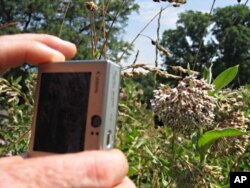It is a simple but chilling statistic: 75 percent of the world's food supply relies on bees, birds and other pollinators, and they're increasingly threatened.
That is part of the conclusion of a two-year study conducted and released Friday by the Intergovernmental Science-Policy Platform on Biodiversity and Ecosystem Services (IPBES).
Tens of thousands of species of insects, birds and bats are a vital part of the natural cycle of pollination, and the study found that a significant percentage of them are at risk.
Sixteen percent of vertebrate pollinators — birds, bats, anything with a backbone — are threatened with global extinction. For isolated populations on islands, like Darwin's finches, the number is nearly double that.
On a local level, in any given community, up to 40 percent of invertebrate species, like bees and butterflies, are threatened.
Pesticides, land use
The report lays out a long list of things that are contributing to the pollinators decline.
IPBES Vice-Chair, Sir Robert Watson, points to changes in land use as the primary factor, adding that "intensive agricultural practices and pesticide use, alien invasive species, diseases and pests, and climate change" also contribute to the pressure on these species.
Pesticides, particularly neonicotinoid pesticides, are singled out as clearly having a negative impact on wild bees.
And while the authors admit they need more information and more studies on the subject, the links are clear.
"While gaps remain in our knowledge of pollinators, we have more than enough evidence to act," said biologist Vera Lucia Imperatriz-Fonseca from the University of Sao Paulo.
Any good news?
IPBES leaders say there are some fairly simple steps that can be taken to reduce the risks, and perhaps invigorate some of these threatened species.
Focusing on bees, which pollinate about one-third of our fruits and vegetables, the report suggests creating more diverse habitats for the wild bees that thrive near agricultural and urban areas, reducing pesticide usage, and managing bee populations to help fight the damage being done by "diseases, pests, and invasive species."
It notes that parasites like the Varroa mite can destroy entire colonies of bees. And it references the relatively recent news that the phorid fly, which was known to infect bumblebees, was also laying its eggs in honeybees, leading them to abandon their hives.
The researchers hope that their study will encourage farmers, scientists and agricultural companies to get together to help protect the industry that is currently delivering over $230 billion worth of crops to the world every year.
"All farmers, especially family farmers and smallholders around the world, benefit from these services" said José Graziano da Silva, director-general of the U.N.'s Food and Agriculture Organization. "Improving pollinator density and diversity has a direct positive impact on crop yields, consequently promoting food and nutrition security."
That's a complicated way of saying that healthy bees mean more food for the nearly 800 million people the U.N. estimates are undernourished.













